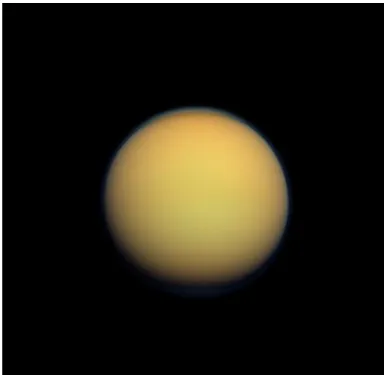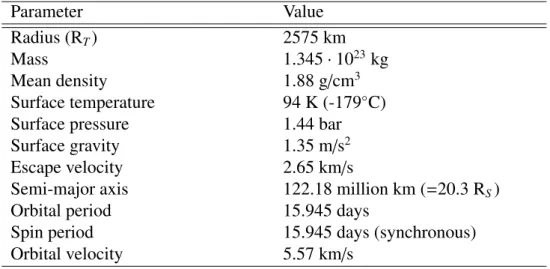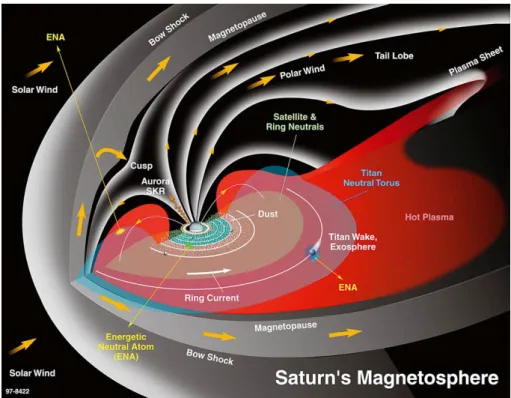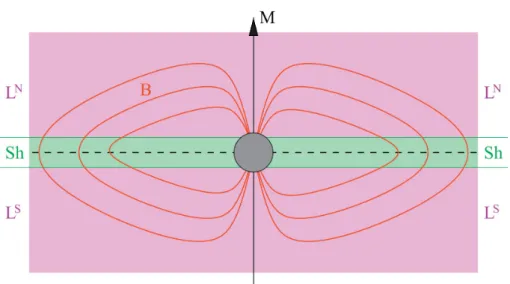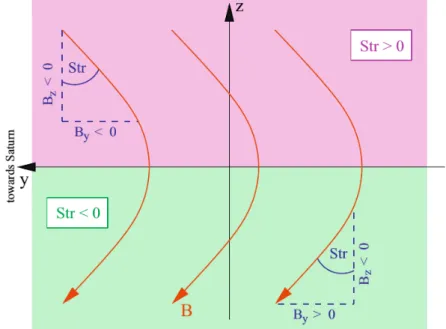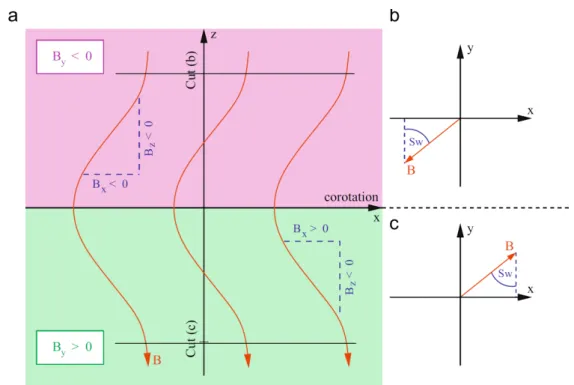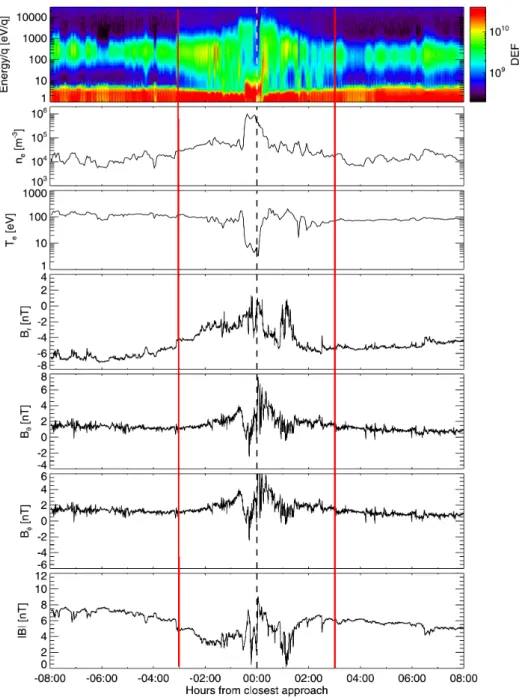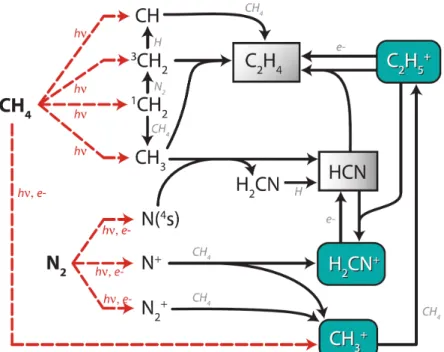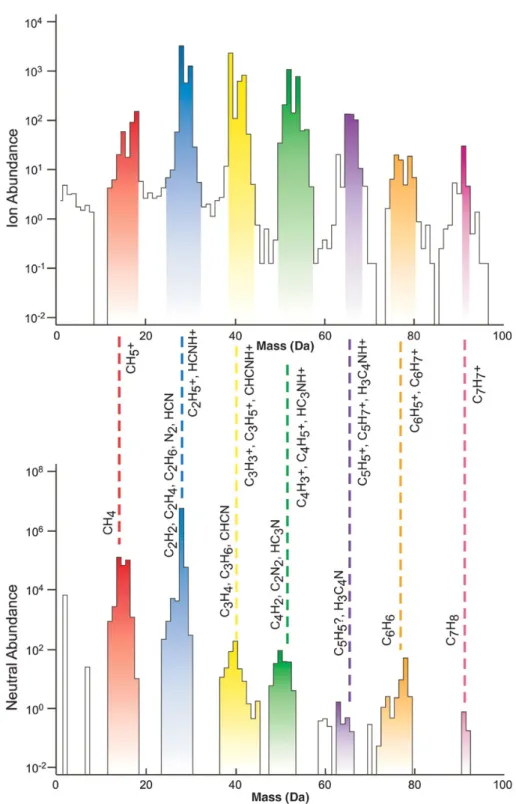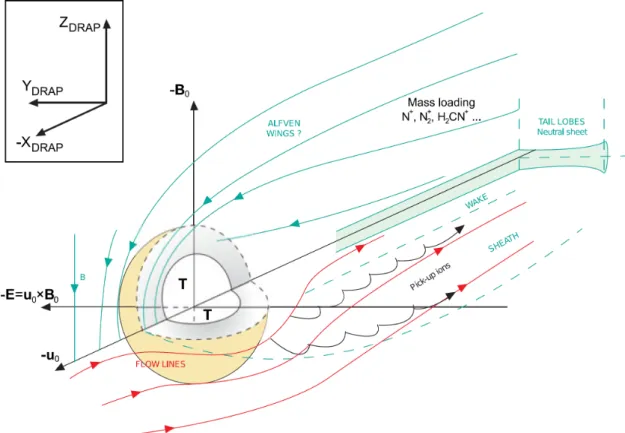Hybrid simulations of Titan’s plasma interaction: Case studies of Cassini’s
T9, T63 and T96 flybys
I n a u g u r a l - D i s s e r t a t i o n zur
Erlangung des Doktorgrades
der Mathematisch-Naturwissenschaftlichen Fakultät der Universität zu Köln
vorgelegt von von Moritz Feyerabend
aus Wedelheine
Köln, 2016
(Gutacher) Prof. Dr. Bülent Tezkan
Tag der mündlichen Prüfung: 31.05.2016
Summary
In this thesis, we apply numerical simulations by means of the hybrid code A.I.K.E.F.
(Adaptive Ion-Kinetic Electron-Fluid) to study the interaction of Saturn’s magnetospheric plasma as well as the solar wind with Titan’s ionosphere. The composition of Titan’s ionosphere is represented by a 7-species model. The ionosphere is generated by a realis- tic wavelength dependent photoionization model of the main neutral species N
2, CH
4and H
2. We also included elastic ion-neutral collisions of the impinging plasma with Titan’s neutral atmosphere to our model as well as a network of the most important chemical reactions of the ionosphere that converts between the ion species.
In the first part of the thesis we investigate the physical processes that lead to the detection of ’split signatures’ in the ion densities during several crossings of the Cassini spacecraft through Titan’s mid-range plasma tail (T9, T63, and T75). During each of these flybys, the Cassini Plasma Spectrometer observed Titan’s ionospheric ion population twice; i.e., the spacecraft passed through two spatially separated regions where cold ions were de- tected. Our simulation results show that the filamentation of Titan’s tail is a common feature of the moon’s plasma interaction. The transport of ionospheric ions of all species from the ramside to the moon’s wakeside generates a cone-like structure on the down- stream side, that contains a region of reduced density. In addition, light (mass 1-2 amu) ionospheric species are driven radially outwards by pressure gradients in the ionosphere and escape along draped magnetic field lines, forming a parabolically shaped filament structure which is mainly seen in planes that contain the upstream magnetospheric mag- netic field and the upstream flow direction. Our results imply that the detections of split signatures during T9, T63 and T75 are consistent by Cassini penetrating through parts of these filament structures.
In the second part of the thesis we study Titan’s plasma interaction with the solar wind
during the Cassini T96 flyby. The T96 encounter marks the only observed event of the
entire Cassini mission where Titan was located in the supersonic solar wind in front of Sat-
urn’s bow shock. We show that the large-scale features of Titan’s induced magnetosphere
during T96 can be described in terms of a steady-state interaction with a high-pressure
solar wind flow. About 40 minutes before the encounter, Cassini observed a rotation of
the incident solar wind magnetic field by almost 90 degrees. We provide strong evidence
that this rotation left a bundle of fossilized magnetic field lines in Titan’s ionosphere that
was subsequently detected by the spacecraft.
Zusammenfassung
In dieser Arbeit benutzen wir numerische Simulationen auf Basis des Hybrid Codes A.I.K.E.F. (Adaptive Ion-Kinetic Electron-Fluid), um die Plasma Wechselwirkung von Titans Ionosphäre mit Saturns magnetosphärischem Plasma als auch dem Sonnenwind zu untersuchen. Die Zusammensetzung von Titans Ionosphäre wird durch ein Modell mit 7 Spezies repräsentiert. Die Ionosphäre wird durch ein realistisches, wellenlängenab- hängiges Photoionisationsmodell der neutralen Hauptspezies N
2, CH
4und H
2generiert.
Desweiteren haben wir elastische Ionen-Neutral Kollisionen des anströmenden Plasmas mit Titans Neutralatmosphäre zu unserem Modell hinzugefügt sowie ein Netzwerk der wichtigsten chemischen Reaktionen der Ionosphäre welches für die Umwandlung der Spezies untereinander sorgt.
Im ersten Teil dieser Arbeit untersuchen wir die physikalischen Prozesse die zur Beobach- tung sogenannter ’split signatures’ in den Ionendichten von mehreren Vorbeiflügen (T9, T63, T75) der Cassini Sonde durch Titans mittel-entfernten Magnetosphärenschweif füh- rten. Während jedem dieser Vorbeiflüge registrierte das Cassini Plasma Spektrometer Titans Ionenpopulation zwei mal: i.,e., das Raumfahrzeug passierte zwei räumlich ge- trennte Regionen in denen kalte Ionen beobachted wurden. Unsere Simulationsergeb- nisse zeigen, dass die Filamentierung von Titans Magnetosphärenschweif eine allgemeine Eigenschaft von Titans Plasmawechselwirkung ist. Der Transport von ionospärischen Io- nen aller Spezies von der Anströmseite zur stromabgewandten Seite erscha ff t eine zylin- derartige Struktur stromabwärts, die eine Region reduzierter Dichte umschliesst. Ausser- dem werden leichte Ionen in der Ionospäre (Masse 1-2 amu) durch Druckgradienten radial auswärts gerichtet beschleunigt und bewegen sich dann entlang drapierter Magnetfeldlin- ien. Dies führt zur Ausbildung von parabolisch geformten Filamenten, welche hauptsäch- lich in Ebenen gesehen werden können die den Magnetfeldvektor und die Richtung des Anströmplasmas enthalten.
Im zweiten Teil der Arbeit untersuchen wir Titans Plasmawechselwirkung mit dem Son-
nenwind während des T96 Vorbeifluges von Cassini. Die T96 Begegnung stellt den einzi-
gen Zeitpunkt der gesamten Cassini Mission dar, in dem Titan im überschall schnellen
Sonnenwind vor Saturns Bugstosswelle eingebettet war. Wir zeigen, dass die gross-
skaligen Eigenschaften von Titans induzierter Magnetospähre während T96 konsistent
sind mit dem Bild einer quasi-stationären Wechselwirkung Titans mit einem Sonnenwind
der einen hohen dynamischen Druck hat. Ungefähr 40 Minuten vor seinem Vorbeiflug
detektierte Cassini dabei eine Rotation des anströmenden Sonnenwindmagnetfeldes um
fast 90 Grad. Wir liefern starke Hinweise, dass diese Rotation ein Bündel von fossil-
isierten Magnetfeldlinien in Titans Ionosphähre hinterlassen hat, welche in der Folge von
der Sonde beobachtet wurden.
Contents
Summary v
Zusammenfassung vii
1 Introduction 1
2 Titan’s Plasma Environment 7
2.1 Saturn’s Magnetospheric Structure . . . . 7
2.1.1 Coordinate System . . . . 11
2.1.2 Dynamics of the Magnetodisk . . . . 12
2.2 Titan’s Atmosphere . . . . 21
2.3 Titan’s Plasma Interaction . . . . 23
2.4 Fossilized Magnetic Fields at Titan . . . . 28
3 Simulation Model 33 3.1 Hybrid Model A.I.K.E.F. . . . 33
3.2 Numerical Implementation . . . . 36
3.3 Titan ionosphere model . . . . 38
3.4 Other Titan simulation models . . . . 42
4 Split Signatures in Titan’s tail 45 4.1 Introduction . . . . 45
4.2 Simulation Setup and Numerical Parameters . . . . 49
4.3 Run #1: Voyager-type upstream conditions . . . . 52
4.3.1 Run #1: Collisions and ∇P
eremoved . . . . 54
4.4 Run #2: T9-type upstream conditions . . . . 56
4.5 Run #3: T63-type upstream conditions . . . . 62
4.5.1 T75 split signatures . . . . 63
4.6 Summary . . . . 64
5 Titan in the Supersonic Solar Wind 67 5.1 Introduction . . . . 67
5.2 Simulation Parameters . . . . 72
5.3 Model Results and Discussion . . . . 75
5.4 Concluding Remarks . . . . 80
6 Summary and Outlook 81 6.1 Outlook . . . . 83
Bibliography 85
Acknowledgements 97
Erklärung 99
1 Introduction
Saturn’s moon Titan has been in the spotlight of scientific interest ever since its discov- ery by Christiaan Huygens in 1655. One of the reasons for that lies in its thick neutral atmosphere, the presence of which has been know from earthbound spectral observations since the early 1940s. The flybys of Pioneer 1 and Voyager 1 in the late 1970s and early 1980s further sparked the interest in the moon, as they confirmed that Titan’s atmosphere is mainly composed of nitrogen. Titan is the only other body in the Solar system except Earth, that has a nitrogen-based atmosphere. It is also the second-largest moon (after Ganymede) in the entire Solar system with a radius of R
T= 2575 km, which puts it even before Mercury regarding the size. The exploration of Titan has been declared one of the major scientific aims of the NASA / ESA Cassini mission that was launched in 1997. Since its arrival in the Saturnian system on 01 July 2004, the Cassini spacecraft has performed
Figure 1.1: Natural color view on Titan from a distance of 191000 km. The picture was taken by Cassini’s Imaging Science Subsystem (ISS) on 30 January, 2012. A thick haze layer of organic compounds in the lower atmosphere gives Titan a yellow-orange color.
Credit: NASA webpage.
117 visits to Titan at the time of writing
1. One of the prime moments of the Cassini mis- sion was the landing of the Huygens landing probe, that provided in-situ measurements of Titan’s atmosphere during its decent on 14 January 2005. Titan therefore states the most distant celestial body where a human-made object has landed. A summary of Titan’s main physical and orbital parameters is provided in table 1.1.
The data gathered by Cassini has revealed that Titan’s atmosphere is the host of a very complex chemistry network which is fueled by nitrogen and methane. The organic com- pounds that are created by this chemistry network are found in a very broad mass range from 1 to ∼10000 amu all over Titan’s atmosphere. At low altitudes, the heaviest species are found as aerosols that form a thick haze layer which gives Titan it’s characteristic yellow-orange appearance (see figure 1.1). Titan’s surface is covered with a crust of frozen water ice and lakes of liquid methane that condensates as a result of the atmo- spheric climate processes. Solar radiation and energetic particles create ionize the neutral atmosphere at high altitudes, which leads to the formation of an extended ionosphere around the moon. Titan is therefore very similar in its atmospheric structure to Earth.
Parameter Value
Radius (R
T) 2575 km
Mass 1.345 · 10
23kg
Mean density 1.88 g / cm
3Surface temperature 94 K (-179
◦C)
Surface pressure 1.44 bar
Surface gravity 1.35 m / s
2Escape velocity 2.65 km / s
Semi-major axis 122.18 million km ( = 20.3 R
S)
Orbital period 15.945 days
Spin period 15.945 days (synchronous)
Orbital velocity 5.57 km / s
Table 1.1: Main physical and orbital parameters of Saturn’s largest moon, Titan.
While Titan’s atmospheric and surface processes are already scientifically very interest- ing, the plasma interaction between Titan and Saturn’s magnetospheric plasma has also been a major topic of the Cassini mission. Since the moon’s orbital velocity is much smaller than the ambient plasma flow, Titan gets constantly overtaken by Saturn’s magne- tospheric plasma. Similar to Mars and Venus, Titan does not possess a noticeable intrinsic or induction-generated magnetic field (Wei et al. 2010) so that the moon’s atmosphere and ionosphere acts as an obstacle to the impinging plasma flow. As a result, the magnetic field lines drape around the moon’s ionosphere which leads to the formation of a char- acteristic perturbation pattern of the magnetic field and plasma flow on the ram side and downstream of the moon (called induced magnetosphere). However, Titan’s plasma in- teraction is unique among that of other non-magnetized bodies in the solar system due to its highly variable plasma environment. Over ten years of observations from Cassini have established the picture of a highly dynamic structure of Saturn’s magnetosphere (see figure 1.2) that is defined by the influences of the solar wind and its internal rotation. The
1
